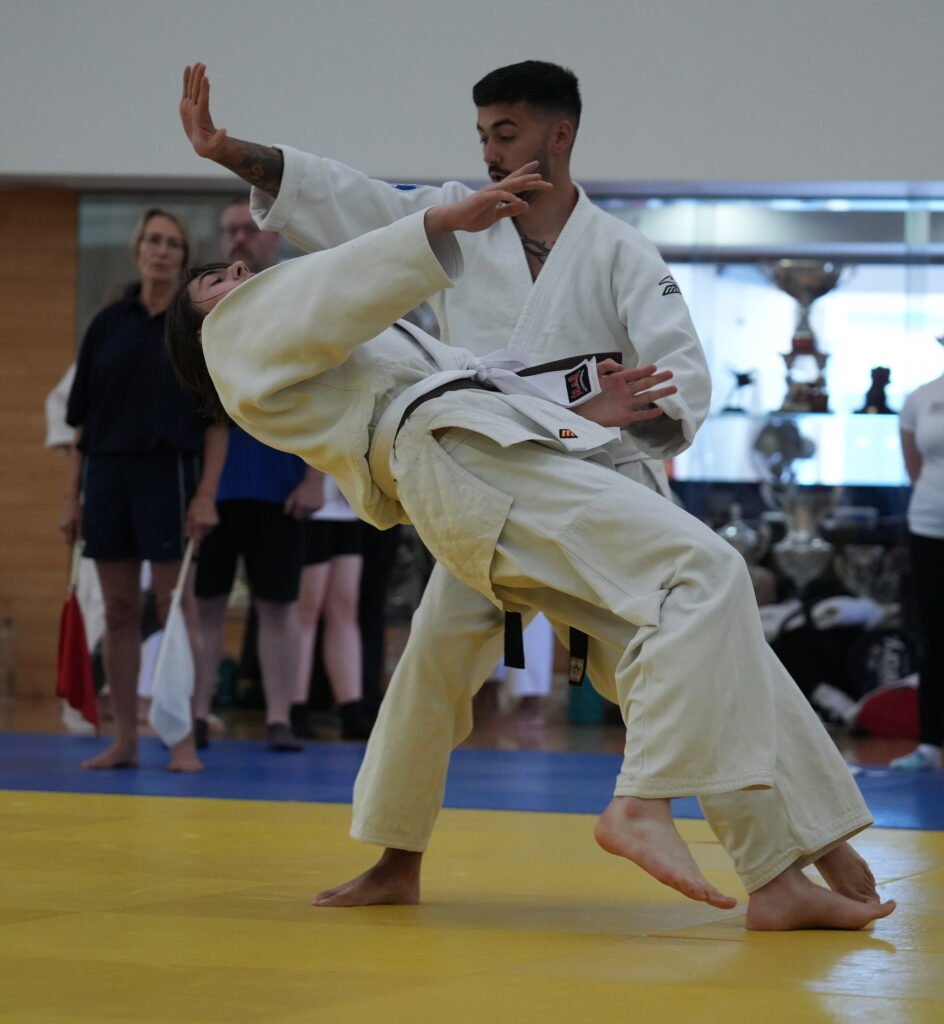FAQs
Have a question about our Martial Arts School? Find answers to common queries below.
Tomiki Aikido is a style of Aikido that incorporates competitive elements and is known for its focus on practical self-defence techniques.
Absolutely! Our club welcomes beginners and provides a supportive environment for learning and practicing Aikido, regardless of experience level.
In Aikido we commonly are recognised for wearing a white Gi/Keikogi/Gogi (derived from Keiko means practice, Gi means dress or clothes) but to start with you can wear any loose clothing such as track suit bottoms and a T-Shirt. After a few weeks of training if Aikido is for you, we would recommend obtaining a Gi for comfort and training exercises. For comfort you can wear a T-shirt underneath your Gi.
Long hair should be tied back and all jewellery removed.
Zori’s (flip-flops) should be worn from the changing room to the edge of the mat as you will train barefoot, never wear any footwear on the mats. By not wearing outdoor shoes, this prevents dirt and dust from being brought onto the tatami (mats).
It is important to remain hydrated throughout any physical activity so please remember to bring the appropriate amount of water throughout our sessions.
There are a number of “hidden” rules we follow when training in the Dojo (training room) the first, learning when its accustomed to rei (bow). Rei’s are done as both a greeting and an expression of thanks. Therefore, Aikidoka bow as a greeting before practicing an Aikido technique and again after practice to thank their training partner. The points where a bow is expected are;
- As you leave the Dojo;
- As you leave the Dojo;
- As you join the mats;
- As you leave the mats;
- As you start to practice an Aikido technique with your training partner;
- After practicing the Aikido technique with your training partner.
If the training session is already in progress, you should kneel and wait at the edge of the mat to invited to join by the coach.
If the coach is explaining a technique, silence is required until completed, tracking the speaker is paramount when learning unfamiliar techniques.
It is important to remain hydrated throughout any physical activity so please remember to bring the appropriate amount of water throughout our sessions.
This is an outline of a typical Aikido training class, which typically lasts about one and a half hours.
- Warm-up (light jogging, running and stretching)
- Ukemi practice – Backward break fall, Forward/Backward roll, Rolling break fall, Variation of flips
- Unsoku – foot movement exercise
- Tandoku-undo – Hand and foot movement exercise;
- Aikido techniques – which could be from a Kata, free practice or preparation for competition.
Some Aikido techniques use joint locks and so you will feel some discomfort as the lock is applied. If the pain of the lock gets too much for you, you should slap your thigh with your hand (if standing) or slap the mat (if lying on the Dojo mats) and your training partner will slacken the hold. Although we are applying locks that are causing restraint it is paramount we look after one another and stop when Uke taps.
Huddersfield Tomiki Aikido Club, as a member of the British Aikido Association (BAA) follows the BAA grading syllabus.
For seniors, the starting grade is 7th Kyu (“red” belt). To gain promotion to subsequent grades or belts (white, yellow, green etc.) and be promoted to a Dan grade (black belt), you will need to pass a grading where you will demonstrate the required number of techniques for the grade to the required standard.
With each grade, the number of techniques to demonstrate increases.
- 6th Kyu (white belt) requires 5 techniques from the Randori-no-kata to be demonstrated;
- 4th Kyu (orange belt) requires 14 techniques from the Randori-no-kata to be demonstrated;
- 2nd Kyu (blue belt) requires:
- all 17 techniques from the Randori-no-kata
- all 10 techniques from the Randori-no-kata-no-ura-waza
- all 7 techniques from Shichi-hon-no-kuzushi
- 1st Dan requires:
- all 17 techniques from the Randori-no-kata
- all 10 techniques from the Randori-no-kata-no-ura-waza
- 14 techniques from the Koryu dai Yon
- 24 techniques from the Koryu dai San
The BAA grading syllabus places an equal emphasis on Embu (Kata) and the application of the Kata techniques in the form of Kakarigeiko, Hikitategeiko and Toshu. You will need to pass both the kata and the application sections to pass a grading.
The BAA does not recognize the award of a Dan grade to young people under the age of 17 years.
Can’t find an Answer?
How to Join

Stop by our location at Huddersfield Leisure Centre to observe a class and meet our instructors.
Participate in a trial class to experience the principles of Aikido firsthand and see if it’s the right fit for you.
After the trial class, sign up for a membership to continue learning and practicing Aikido techniques with our experienced instructors.
Join our regular classes to deepen your understanding of Traditional and Tomiki Aikido, improving your self-defense skills.
